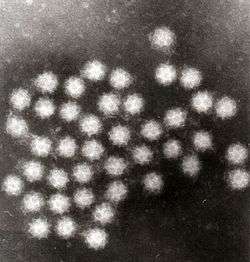Sapovirus
| Sapporo virus | |
|---|---|
 | |
| Transmission electron micrograph of Sapporo viruses. | |
| Virus classification | |
| Group: | Group IV ((+)ssRNA) |
| Family: | Caliciviridae |
| Genus: | Sapovirus |
| Type Species | |
| |
Sapovirus is a genus of viruses, in the family Caliciviridae. Humans and swine serve as natural hosts.[1] There is currently only one species in this genus: the type species Sapporo virus.[1][2][3] Together with the Norwalk virus, these are the most common cause of acute viral gastroenteritis in adults.[1][4] Unlike Noroviruses, however, Sapoviruses generally only causes mild gastroenteritis in young children.[5] The type species (and the genus by extension) is named after Sapporo, Japan where the virus was first discovered following an outbreak of gastroenteritis in an orphanage.[6]
Structure
Viruses in Sapovirus are non-enveloped, with icosahedral geometries, and T=3 symmetry. The diameter is around 27-40 nm. Genomes are linear and non-segmented, around 8.3kb in length.[1]
| Genus | Structure | Symmetry | Capsid | Genomic Arrangement | Genomic Segmentation |
|---|---|---|---|---|---|
| Sapovirus | Icosahedral | T=3 | Non-Enveloped | Linear | Monopartite |
Life Cycle
Viral replication is cytoplasmic. Entry into the host cell is achieved by attachment to host receptors, which mediates endocytosis. Replication follows the positive stranded RNA virus replication model. Positive stranded RNA virus transcription is the method of transcription. Translation takes place by RNA termination-reinitiation. Humans and swine serve as the natural host. Transmission routes are fecal-oral.[1]
| Genus | Host Details | Tissue Tropism | Entry Details | Release Details | Replication Site | Assembly Site | Transmission |
|---|---|---|---|---|---|---|---|
| Sapovirus | Humans; swine | Intestinal epithelium | Cell receptor endocytosis | Lysis | Cytoplasm | Cytoplasm | Oral-fecal |
Taxonomy
Group: ssRNA(+)
- Family: Caliciviridae
- Genus: Sapovirus
- Sapporo virus
Sapovirus are currently classified into seven genogroups (GI to GVII) based on the complete sequence of capsid. GI, GII, GIV and GV are known to infect humans [7]
Animal viruses
Sapoviruses have been identified in bats, California sea lions, dogs, pigs and mink.[8][9]
References
- 1 2 3 4 5 "Viral Zone". ExPASy. Retrieved 15 June 2015.
- ↑ Hansman GS, Oka T, Katayama K, Takeda N (2007). "Human sapoviruses: genetic diversity, recombination, and classification". Reviews in Medical Virology. 17 (2): 133–41. doi:10.1002/rmv.533. PMID 17340567.
- 1 2 ICTV. "Virus Taxonomy: 2014 Release". Retrieved 15 June 2015.
- ↑ Blanton LH, Adams SM, Beard RS, et al. (2006). "Molecular and epidemiological trends of caliciviruses associated with outbreaks of acute gastroenteritis in the United States, 2000–2004". J Infect Dis. 193 (3): 413–21. doi:10.1086/499315. PMID 16388489.
- ↑ Moreno-Espinosa S, Farkas T, Jiang X (October 2004). "Human caliciviruses and pediatric gastroenteritis". Seminars in Pediatric Infectious Diseases. 15 (4): 237–45. doi:10.1053/j.spid.2004.07.004. PMID 15494947.
- ↑ Chiba S, Sakuma Y, Kogasaka R, Akihara M, Terashima H, Horino K, Nakao T (August 1980). "Fecal shedding of virus in relation to the days of illness in infantile gastroenteritis due to calicivirus". The Journal of Infectious Diseases. 142 (2): 247–9. doi:10.1093/infdis/142.2.247. PMID 7410899.
- ↑ Farkas, T; Zhong, WM; Jing, Y; Huang, PW; Espinosa, SM; Martinez, N; Morrow, AL; Ruiz-Palacios, GM; Pickering, LK; Jiang, X (July 2004). "Genetic diversity among sapoviruses.". Archives of Virology. 149 (7): 1309–23. doi:10.1007/s00705-004-0296-9. PMID 15221533.
- ↑ Meng XJ (January 2012). "Emerging and Re-emerging Swine Viruses". Transboundary and Emerging Diseases. 59: 85–102. doi:10.1111/j.1865-1682.2011.01291.x. PMID 22225855.
- ↑ Tse H, Chan WM, Li KS, Lau SK, Woo PC, Yuen KY (2012) Discovery and genomic characterization of a novel bat sapovirus with unusual genomic features and phylogenetic position. PLoS One 7(4):e34987.